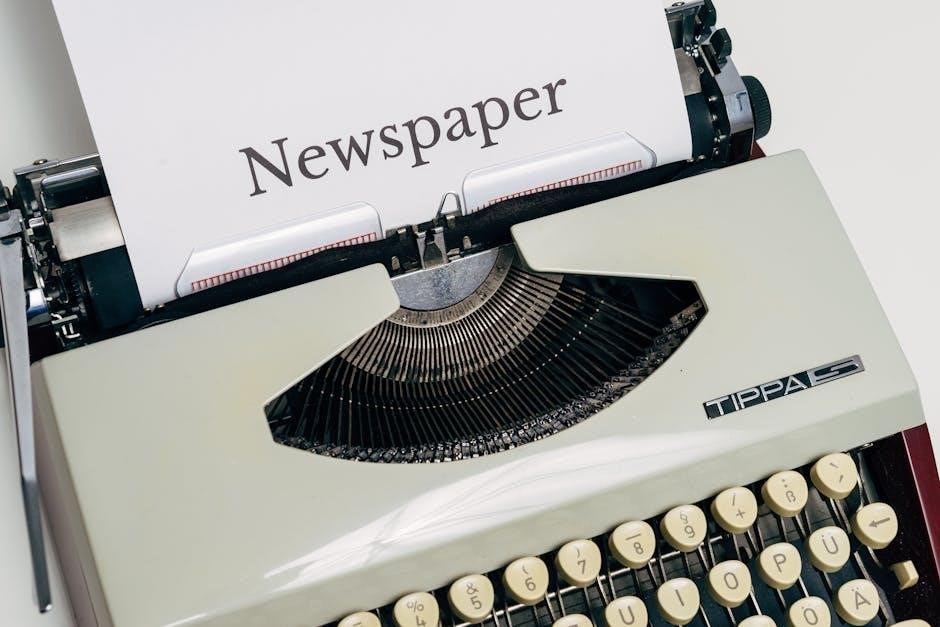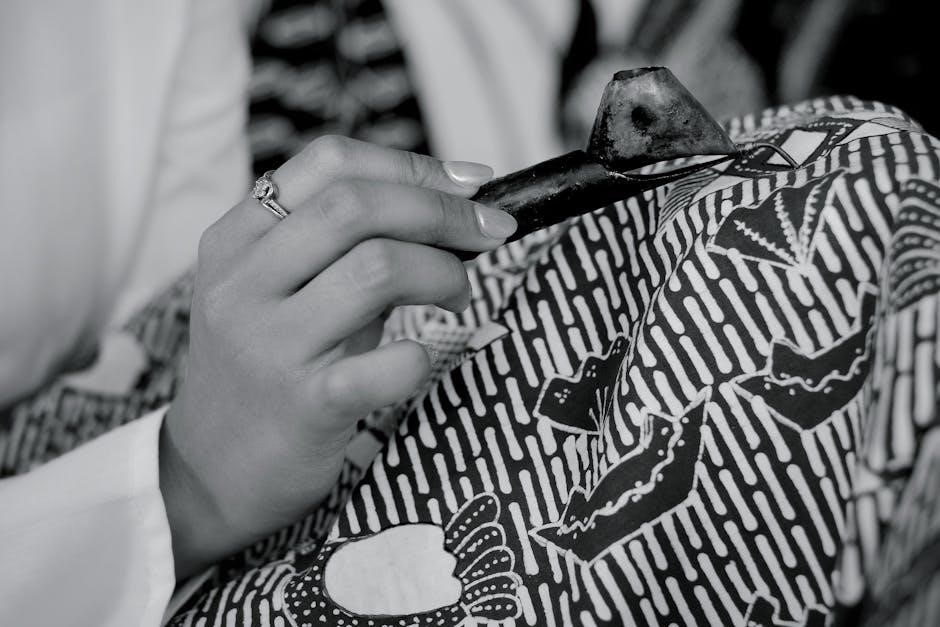Manual printing is a traditional‚ hands-on method for creating unique designs on various surfaces. It combines artistic expression with technical skill‚ offering versatility in texture and color. This accessible technique requires minimal equipment‚ making it a popular choice for artisans‚ designers‚ and crafters. Its applications span fine art‚ textiles‚ and industrial uses‚ ensuring its enduring relevance in modern creative processes.
1.1 Definition and Overview of Manual Printing
Manual printing is a hands-on technique involving transferring designs onto surfaces using physical tools. It combines artistic creativity with precision‚ relying on traditional methods like screens‚ blocks‚ or plates; This versatile process is rooted in history‚ offering unique textures and finishes for artistic‚ industrial‚ and cultural applications.
1.2 Historical Context and Evolution
Manual printing traces its origins to ancient civilizations‚ with techniques like woodblock printing emerging in China around 200 AD. The invention of movable type in Korea and Gutenberg’s press in Europe revolutionized the process. Over centuries‚ it evolved into diverse methods‚ blending tradition with modern innovations while retaining its artistic essence.
Techniques and Methods in Manual Printing
Manual printing encompasses various traditional and contemporary methods‚ including screen printing‚ relief printing‚ intaglio‚ and stenciling. Each technique offers unique artistic and practical advantages‚ catering to diverse creative and industrial needs.
2.1 Screen Printing
Screen printing involves transferring ink through a stencil on a mesh screen. It is widely used for posters‚ textiles‚ and promotional materials‚ offering vibrant‚ durable results with minimal equipment and cost.
2.2 Relief Printing (Woodblock and Linocut)
Relief printing involves carving designs into wood or linoleum blocks‚ inking them‚ and transferring to surfaces. It produces bold‚ graphic prints and is widely used in artistic‚ textile‚ and packaging applications.
2.3 Intaglio Printing
Intaglio printing involves etching designs onto metal plates‚ inking the recessed areas‚ and transferring the image under pressure. It creates detailed‚ intricate designs and is often used in fine art‚ currency‚ and high-security documents due to its precision and durability.
Tools and Materials Required
Manual printing requires specialized tools like printing presses‚ inks‚ plates‚ and substrates. Essential materials include screens‚ blocks‚ and hand tools‚ allowing for creative and precise printing results across various mediums.
3.1 Printing Inks and Their Types
Printing inks vary in composition‚ with water-based‚ oil-based‚ and solvent-based options. Each type suits specific substrates and techniques‚ offering durability‚ vibrancy‚ or eco-friendliness. Modern formulations emphasize sustainability and performance for diverse manual printing applications.
3.2 Screens‚ Plates‚ and Blocks
Screens‚ plates‚ and blocks are essential tools in manual printing. Screens are used in screen printing‚ while plates and blocks are utilized in relief and intaglio techniques. They are typically made from materials like metal‚ wood‚ or linoleum‚ allowing for detailed design transfers onto substrates.
3.3 Printing Presses and Hand Tools
Printing presses and hand tools are vital for manual printing‚ enabling precise control over ink transfer and design execution. They include etching presses‚ relief presses‚ and handheld tools like brayers and burnishers‚ ensuring versatility and quality in various printing techniques.
3.4 Substrates (Paper‚ Fabric‚ etc.)
Manual printing utilizes diverse substrates‚ including paper‚ fabric‚ and other materials. Each substrate offers unique textures and durability‚ significantly influencing print quality and longevity‚ making them suitable for various artistic and industrial applications.
3.5 Consumables and Accessories
Manual printing requires specific consumables like inks‚ cleaning solvents‚ and accessories such as squeegees‚ rollers‚ and cutting tools. These materials ensure optimal print quality‚ durability‚ and precision‚ catering to various techniques and substrate requirements in both artistic and industrial settings.

Applications of Manual Printing
Manual printing is versatile‚ used in artistic designs‚ textiles‚ packaging‚ and signage. It offers unique textures and customization‚ making it ideal for creative and industrial applications alike.
4.1 Artistic and Creative Uses
Manual printing is a cornerstone of artistic expression‚ enabling unique textures and vibrant designs. Artists use techniques like screen printing and linocut to create intricate‚ handcrafted pieces. Its tactile nature allows for experimentation‚ making it a favorite in fine art‚ DIY projects‚ and custom designs.
4.2 Textile Printing
Manual printing is widely used in textile printing for fashion and craft projects. Techniques like screen printing and hand stamping allow for custom‚ unique designs on fabrics‚ offering versatility in patterns and colors for personalized and artistic textile outcomes.
4.3 Packaging and Labeling
Manual printing is ideal for custom packaging and labeling‚ offering unique designs and small-batch production. It enhances brand identity with intricate details and vibrant colors‚ making it popular for luxury goods‚ artisanal products‚ and personalized packaging solutions.

4.4 Signage and Advertising
Manual printing excels in creating vibrant‚ high-quality signage and advertisements. Techniques like screen printing ensure bold‚ durable graphics for posters‚ banners‚ and signage. Its versatility allows for custom designs on various materials‚ making it a preferred method for impactful visual communication in marketing and branding efforts.

Troubleshooting Common Issues
Manual printing often faces challenges like ink smudging‚ misalignment‚ and substrate handling. Identifying these issues early ensures high-quality outputs and minimizes waste‚ enhancing overall efficiency.
5.1 Ink Consistency and Adhesion Problems
Ink consistency and adhesion problems are common in manual printing‚ often causing smudging or uneven coverage. Adjusting ink viscosity‚ ensuring proper surface preparation‚ and monitoring environmental conditions can help mitigate these issues‚ improving print quality and durability.
5.2 Misregistration and Alignment Issues
Misregistration and alignment problems in manual printing occur when designs don’t align properly‚ causing uneven or distorted images. Ensuring accurate press setup‚ using registration marks‚ and verifying substrate positioning can help correct these issues‚ achieving precise and professional-looking results consistently.
5.3 Substrate Feeding and Handling
Substrate feeding and handling in manual printing require careful alignment and smooth movement to avoid jams and misalignment. Properly positioning materials‚ using guides‚ and handling gently ensures accurate results. Adjusting press tension and maintaining even pressure helps prevent feeding issues and improves overall print quality.

5.4 Drying Time and Curing Challenges
Drying time and curing challenges in manual printing depend on environmental factors like humidity and temperature. Inks may take longer to dry in moist conditions‚ while high heat can cause premature curing; Proper ventilation and substrate preparation are essential to ensure even drying and long-lasting results.

Safety and Best Practices
Safety is crucial in manual printing. Use PPE like gloves and goggles to protect against chemicals and ink. Ensure proper workspace ventilation and organization to prevent accidents. Follow guidelines for handling materials and dispose of waste responsibly to maintain a safe and sustainable environment.
6.1 Personal Protective Equipment (PPE)
Manual printing requires essential PPE‚ including gloves‚ goggles‚ masks‚ and aprons‚ to protect against ink‚ chemicals‚ and dust. These items prevent skin irritation‚ eye splashes‚ and inhalation of harmful particles‚ ensuring a safer working environment.
6.2 Workspace Setup and Ventilation
A well-organized workspace with proper ventilation is crucial for manual printing. Use fans or open windows to remove fumes from inks and chemicals. Ensure good lighting and organize tools to avoid accidents. A sturdy worktable and clean environment enhance safety and efficiency.
6.3 Waste Disposal and Sustainability
Proper waste disposal and sustainable practices are essential in manual printing. Recycle materials like paper and ink cartridges‚ and dispose of hazardous chemicals safely. Use eco-friendly inks and minimize waste by planning projects carefully. Choose biodegradable alternatives to reduce environmental impact.
DIY vs. Commercial Manual Printing
DIY manual printing offers cost-effectiveness and creative control for small projects‚ while commercial printing provides scalability‚ precision‚ and efficiency for large-scale production needs.
7.1 Cost Comparison
DIY manual printing involves lower initial costs‚ with minimal equipment and materials‚ ideal for small-scale projects. Commercial printing‚ while more expensive upfront‚ offers economies of scale for large volumes‚ reducing per-unit costs and optimizing production efficiency over time.

7.2 Quality and Precision Differences
Commercial manual printing often achieves higher precision and consistency due to advanced tools and expertise. DIY methods may lack uniformity but offer a unique‚ handmade quality‚ making them ideal for artistic or small-batch projects where personal touch is valued over perfection.
7.3 Scalability and Production Volume
Commercial manual printing is scalable‚ handling large production volumes efficiently. DIY methods are better suited for small batches‚ as scaling up requires significant time and effort‚ making commercial setups more practical for high-demand projects.
7.4 Time and Labor Requirements
Commercial manual printing often demands significant labor for setup and operation‚ while DIY methods require more time per print but are manageable for smaller quantities‚ balancing efficiency and personal involvement based on production needs.
Environmental Impact and Sustainability
Manual printing’s environmental impact is minimized through eco-friendly inks‚ sustainable materials‚ and waste reduction practices‚ promoting energy efficiency and responsible resource use for a greener future.
8.1 Eco-Friendly Inks and Materials
Eco-friendly inks and materials in manual printing include biodegradable and non-toxic options‚ such as plant-based dyes and soy-based inks‚ reducing environmental harm. Sustainable sources like recycled paper and organic fabrics further mitigate ecological impact‚ promoting greener production processes and waste reduction.

8.2 Sustainable Practices in Manual Printing
Sustainable practices in manual printing emphasize minimizing waste and optimizing resources. Techniques include reusing materials‚ reducing ink consumption‚ and employing renewable energy sources. These methods ensure eco-conscious production while maintaining quality and efficiency in the printing process.

8.3 Energy Consumption and Efficiency
Manual printing often requires less energy compared to industrial methods‚ relying on hand tools or small-scale presses. Optimizing press setups and using energy-efficient equipment can further reduce consumption‚ promoting eco-friendly practices while maintaining production quality and efficiency.
8.4 Waste Management and Recycling
Manual printing emphasizes sustainable waste management by recycling materials like paper and fabric scraps‚ and responsibly disposing of inks and solvents. Using biodegradable inks and minimizing excess materials helps reduce environmental impact. Educating printers on proper disposal methods is crucial for eco-friendly practices.

Future Trends in Manual Printing
Manual printing is evolving with advancements in digital integration‚ hybrid techniques‚ and smart materials. These innovations enhance customization‚ efficiency‚ and sustainability‚ shaping the future of the craft.
9.1 Integration with Digital Technology
Manual printing is embracing digital tools‚ enhancing creativity and efficiency. Design software and hybrid techniques merge traditional methods with modern tech‚ offering precision and customization. Laser cutting and digital ink management systems further expand possibilities‚ ensuring manual printing remains relevant in a tech-driven world.
9.2 Hybrid Printing Methods
Hybrid printing combines manual techniques with digital technology‚ offering enhanced precision and versatility. This fusion allows for intricate designs‚ blending traditional craftsmanship with modern efficiency. Digital pre-press and inkjet systems integrate seamlessly with manual printing‚ expanding creative possibilities while maintaining the unique charm of handmade processes.
9.3 Customization and Personalization
Manual printing enables unparalleled customization‚ allowing for unique‚ tailored outputs. Its adaptability permits intricate designs‚ varied materials‚ and specialized finishes‚ making it ideal for personalized projects‚ niche markets‚ and artistic expressions requiring distinctiveness and precision.
9.4 Smart Materials and Innovations
Advancements in smart materials and innovations are transforming manual printing. Eco-friendly inks‚ conductive substrates‚ and self-healing coatings enhance durability and efficiency. Integration with digital tools and hybrid methods expand creative possibilities‚ ensuring sustainability and precision in modern applications.
Mastering manual printing requires patience‚ practice‚ and attention to detail. Embrace safety protocols‚ explore sustainable materials‚ and stay curious about new techniques to elevate your craft and creativity.
10.1 Key Takeaways for Successful Manual Printing
Mastering manual printing involves understanding fundamentals‚ experimenting with techniques‚ and solving common issues. Prioritize safety‚ use eco-friendly materials‚ and stay updated on trends. Practice consistency‚ precision‚ and patience to achieve high-quality results while fostering creativity and sustainability in your work.
10.2 Resources for Further Learning
Explore online tutorials‚ workshops‚ and books for in-depth manual printing knowledge. Join communities‚ attend classes‚ and follow expert blogs to refine skills and discover innovative techniques. Utilize creative platforms for inspiration and hands-on learning opportunities.
10.3 Encouragement to Experiment and Innovate
Experimentation is key to mastering manual printing. Try new techniques‚ materials‚ and designs to create unique pieces. Embrace sustainability by using eco-friendly inks and recycled substrates. Share your work online or in communities for feedback and inspiration. Let your creativity shine and continuously push boundaries.